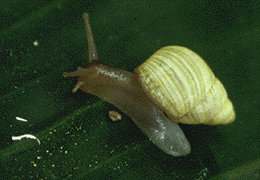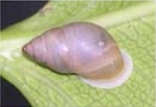Partula
| Partula | ||||||||||||
|---|---|---|---|---|---|---|---|---|---|---|---|---|

|
||||||||||||
| Systematics | ||||||||||||
|
||||||||||||
| Scientific name | ||||||||||||
| Partula | ||||||||||||
| Férussac , 1821 |
Partula is the name of a genus of snails in the family Partulidae , nocturnal, viviparous tree snails that are common in Polynesia . Due to the destruction of the habitat and the introduction of invasive animal species, most of the approximately 75 known species have become extinct.
features
The usually not more than 2 cm in adult worm long housing are wound right or left, usually pointed ovate with a tapered thread. The bulbous body is higher than the thread. The case mouth is short and reinforced with teeth or waves. The snails, like other lung snails, are hermaphrodites that mate with their penises . The young snails are born alive. The snails live on dead plant material and microscopic vegetation of the trees on which they live.
distribution
The snails live on trees in the forests of the islands of the Pacific from the Society Islands to Palau . This is where the common name “Polynesian tree snails” comes from, but it is also used to refer to other snails such as B. the genus Achatinella in Hawaii . The Partula species investigated in Tahiti were found in particular on the underside of the leaves of caladium and banana trees , as well as on dragon trees and turmeric .
Danger
The destruction of forests and the introduction of African great agate snails ( Achatina fulica ), which successfully displaced the native snail species through food competition , are seen in connection with the decline and extinction of the Partula species. To combat agate snails, predatory rosy wolf snails ( Euglandina rosea ) were released in 1974 , but instead of agate snails they ate the native species. The wolf snail, which spread from Tahiti to numerous islands, has been recognized as the main cause of the destruction of the Partula snails. On other islands, so on Guam , which is from Guinea entrained land planarian Platydemus Manokwari as the main cause of the disappearance of Partula suspected TYPES and other native snails. The Zoological Society of London is now running a program to conserve the remaining Partula species in captivity in the UK , France and the USA (Partula Program Consortium).
2013, according to the Red List of IUCN , the 14 remaining wild Partula TYPES "threatened with extinction" (critically endangered) , 11 species are "extinct in the wild" (extinct in the wild) and 51 died (extinct) and 5 Species are no data available (data deficient ).
Importance to humans
The snail shells were once used by the Polynesians as ceremonial jewelry. The zoologists Henry Crampton and Yoshio Kondo became aware of the snails and examined them over a period of 50 years. Based on the large amount of data on morphological diversity, ecological niches and behavior, they were able to describe a classic example of adaptive radiation .
Systematics
The genus Partula includes the following species:
- Partula affinis - extinct
- Partula approximata - extinct
- Partula arguta - extinct
- Partula atilis - extinct
- Partula aurantia - extinct
- Partula auriculata - extinct
- Partula bilineata - extinct
- Partula callifera - extinct
- Partula calypso
- Partula candida - extinct
- Partula castanea - extinct
- Partula cedista - extinct
- Partula citrina - extinct
- Partula clara
- Partula compacta - extinct
- Partula crassilabris - extinct
- Partula cuneata - extinct
- Partula cytherea - extinct
- Partula dentifera
- Partula dolichostoma - extinct
- Partula dolorosa - extinct
- Partula emersoni
- Partula eremita - extinct
- Partula exigua - extinct
- Partula faba
- Partula filosa
- Partula formosa - extinct
- Partula fusca - extinct
- Partula garretti
- Partula gibba
- Partula guamensis
- Partula lift
- Partula hyalina
- Partula imperforata - extinct
- Partula labrusca - extinct
- Partula langfordi
- Partula leptochila - extinct
- Partula leucothoe
- Partula levilineata - extinct
- Partula levistriata - extinct
- Partula lutea - extinct
- Partula martensiana
- Partula microstoma - extinct
- Partula mirabilis
- Partula mooreana
- Partula nodosa
- Partula otaheitana
- Partula planilabrum - extinct
- Partula producta - extinct
- Partula protea - extinct
- Partula protracta - extinct
- Partula radiata - extinct
- Partula radiolata
- Partula raiatensis - extinct
- Partula remota - extinct
- Partula robusta - extinct
- Partula rosea
- Partula rustica - extinct
- Partula sagitta - extinct
- Partula salifana - extinct
- Partula salifera - extinct
- Partula suturalis
- Partula taeniata
- Partula thalia - extinct
- Partula thetis
- Partula tohiveana
- Partula tristis
- Partula turgida - extinct
- Partula umbilicata - extinct
- Partula varia
- Partula variabilis - extinct
- Partula vittata - extinct
literature
- George W. Tryon and Henry A. Pilsbry : Manual of Conchology. Structural and Systematic . Volume XX. Caecilioides, Glessula and Partulidae . Conchological Department, Philadelphia, 1909-1910. Partula FER. , Pp. 155-320.
- Alfred Goldsborough Mayor (1902): Some species of Partula from Tahiti. A study in variation . Memoirs of the Museum of Comparative Zoology XXVI (2) , Cambridge, USA.
- Henry E. Crampton (1916): Studies on the variation, distribution and evolution of the genus Partula. The species inhabiting Tahiti. Carnegie Institution of Washington , 228, pp. 1-311.
- Henry E. Crampton (1925): Studies on the variation, distribution and evolution of the genus Partula. The species of the Mariana Islands, Guam and Saipan. Carnegie Institution of Washington, 228a, pp. 1-116.
- Henry E. Crampton (1932): Studies on the variation, distribution and evolution of the genus Partula. The species inhabiting Moorea. Carnegie Institution of Washington, 410, pp. 1-335.
Web links
- weichtiere.at: Polynesian tree snails (Partula)
- Barry D. Smith, Ramsay Cooper-Nurse, Ann Marie Gawel: Survey of the endangered tree snails on navy-owned land in Guam (PDF; 1.3 MB)
Individual evidence
- ^ F. Welter Schultes: Genus taxon summary for Partula . In: Georg-August-Universität Göttingen (Ed.): AnimalBase . ( online [accessed March 16, 2014]).
- ^ André E. de Férussac : Tableaux systématiques des animaux mollusques classés en familles naturelles: suivis d'un prodrome général pour tous les mollusques terrestres ou fluviatiles . Bertrand, Paris 1822. p. 65. genre cinquième. Partule, Partula .
- ↑ World Association if Zoos and Aquariums WAZA: Pacific Tree Snails (Partula spp.)
- ^ Searching for " Partula ". In: IUCN 2010. IUCN Red List of Threatened Species. Version 2010.3.
- ^ Platydemus manokwari (flatworm): General Impact . Global Invasive Species Database. Retrieved October 12, 2015.
- ^ IUCN (2013). IUCN Red List of Threatened Species . Version 2013.2
- ↑ Younghun Jung, Lee Taehwan, John B. Burch, Diarmaid Ó Foighil (2005): Historical phylogeny of Tahitian Partula . Proc. Joint Conference - American Malacological Society and Western Society of Malacologists.




